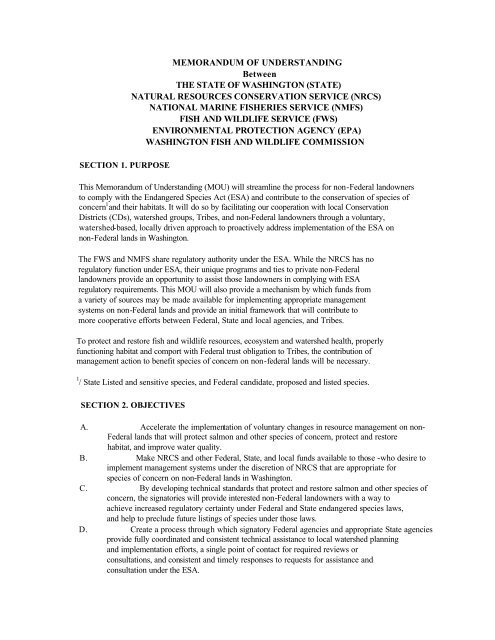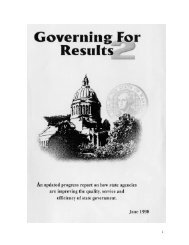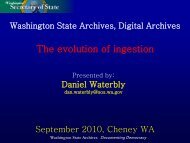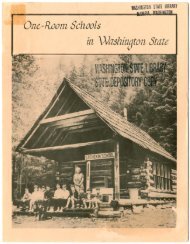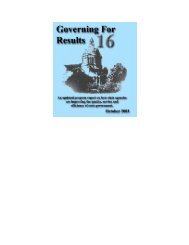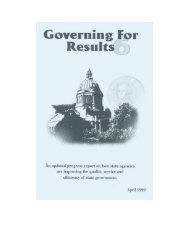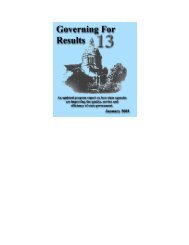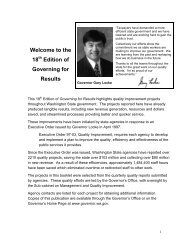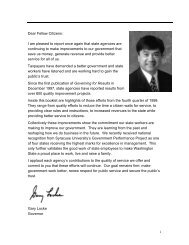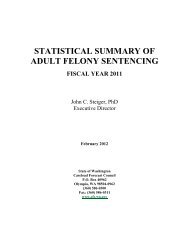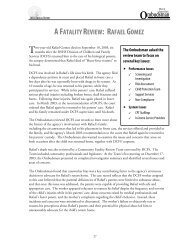MEMORANDUM OF UNDERSTANDING Between THE STATE OF ...
MEMORANDUM OF UNDERSTANDING Between THE STATE OF ...
MEMORANDUM OF UNDERSTANDING Between THE STATE OF ...
You also want an ePaper? Increase the reach of your titles
YUMPU automatically turns print PDFs into web optimized ePapers that Google loves.
SECTION 1. PURPOSE<br />
<strong>MEMORANDUM</strong> <strong>OF</strong> <strong>UNDERSTANDING</strong><br />
<strong>Between</strong><br />
<strong>THE</strong> <strong>STATE</strong> <strong>OF</strong> WASHINGTON (<strong>STATE</strong>)<br />
NATURAL RESOURCES CONSERVATION SERVICE (NRCS)<br />
NATIONAL MARINE FISHERIES SERVICE (NMFS)<br />
FISH AND WILDLIFE SERVICE (FWS)<br />
ENVIRONMENTAL PROTECTION AGENCY (EPA)<br />
WASHINGTON FISH AND WILDLIFE COMMISSION<br />
This Memorandum of Understanding (MOU) will streamline the process for non-Federal landowners<br />
to comply with the Endangered Species Act (ESA) and contribute to the conservation of species of<br />
concern 1 and their habitats. It will do so by facilitating our cooperation with local Conservation<br />
Districts (CDs), watershed groups, Tribes, and non-Federal landowners through a voluntary,<br />
watershed-based, locally driven approach to proactively address implementation of the ESA on<br />
non-Federal lands in Washington.<br />
The FWS and NMFS share regulatory authority under the ESA. While the NRCS has no<br />
regulatory function under ESA, their unique programs and ties to private non-Federal<br />
landowners provide an opportunity to assist those landowners in complying with ESA<br />
regulatory requirements. This MOU will also provide a mechanism by which funds from<br />
a variety of sources may be made available for implementing appropriate management<br />
systems on non-Federal lands and provide an initial framework that will contribute to<br />
more cooperative efforts between Federal, State and local agencies, and Tribes.<br />
To protect and restore fish and wildlife resources, ecosystem and watershed health, properly<br />
functioning habitat and comport with Federal trust obligation to Tribes, the contribution of<br />
management action to benefit species of concern on non-federal lands will be necessary.<br />
1 / State Listed and sensitive species, and Federal candidate, proposed and listed species.<br />
SECTION 2. OBJECTIVES<br />
A. Accelerate the implementation of voluntary changes in resource management on non-<br />
Federal lands that will protect salmon and other species of concern, protect and restore<br />
habitat, and improve water quality.<br />
B. Make NRCS and other Federal, State, and local funds available to those -who desire to<br />
implement management systems under the discretion of NRCS that are appropriate for<br />
species of concern on non-Federal lands in Washington.<br />
C. By developing technical standards that protect and restore salmon and other species of<br />
concern, the signatories will provide interested non-Federal landowners with a way to<br />
achieve increased regulatory certainty under Federal and State endangered species laws,<br />
and help to preclude future listings of species under those laws.<br />
D. Create a process through which signatory Federal agencies and appropriate State agencies<br />
provide fully coordinated and consistent technical assistance to local watershed planning<br />
and implementation efforts, a single point of contact for required reviews or<br />
consultations, and consistent and timely responses to requests for assistance and<br />
consultation under the ESA.
SECTION 3. BACKGROUND<br />
A. The Pacific Northwest faces significant and extensive land and water management<br />
challenges to meet society's need for sustainable resources while maintaining ecosystem<br />
functions and healthy populations of fish and wildlife, especially for species of concern.<br />
A number of species occurring in Washington are currently listed or proposed for listing<br />
under State and Federal endangered species laws. In addition, 666 stream segments have<br />
recently been designated in Washington as water quality limited under the Federal Clean<br />
Water Act (CWA) because, in most cases, they do not support the beneficial uses<br />
associated with aquatic habitats.<br />
B. The NMFS and the FWS each have significant responsibilities for ecosystem protection<br />
on non-Federal lands, and recognize a common purpose in reducing environmental<br />
degradation and preserving and restoring habitat needed to maintain viable populations of<br />
native species. With existing and impending ESA listings, these agencies must act in a<br />
manner that protects ecosystem and watershed health, maintains the full range of natural<br />
resource values, comports with Federal trust obligation to Tribes, and complies with ESA<br />
requirements, while providing increased predictability to non-Federal landowners as they<br />
carry out management activities. Watershed management plans developed under the terms of<br />
this MOU may apply the provisions of section 7(a)(2) of the ESA when using NRCS<br />
financial assistance for implementation of the plan.<br />
Actions carried out without NRCS financial assistance may use section 10(a)(1)(B) unless<br />
section 7(a)(2) is triggered by another Federal action. The signatories recognize that a<br />
conservation program for any species that occurs to a large extent on non-Federal land<br />
cannot be successful without the cooperation and active participation of non-Federal<br />
landowners.<br />
C. The NRCS delivers technical services and programs to private non-Federal landowners<br />
and Tribes, upon request, through cooperative agreements with CDs (which are sub-units<br />
of State government), with elected directors that provide local leadership in resource<br />
management on non-Federal lands. Through cooperative agreements with the NRCS and<br />
Washington State at the State level, and with the Secretary of Agriculture at the national<br />
level, CDs provide local non-Federal landowners access to NRCS technical assistance<br />
and various programs authorized under the Farm Bill. NRCS has a traditional role in<br />
providing assistance to non-Federal landowners who voluntarily plan and apply<br />
appropriate conservation measures to maintain or enhance the health of their watershed.<br />
NRCS has the flexibility to extend this role to include consideration of species of<br />
concern.<br />
D. EPA has either direct or oversight responsibilities for a number of regulatory programs<br />
which may affect critical habitats, air, and water quality. In recent years, EPA has begun<br />
emphasizing geographic approaches which integrate local involvement with various<br />
levels of government to holistically address environmental protection. This emphasis has<br />
resulted in both organizational changes and an effort to utilize geographic prioritization<br />
of coordinated available funding sources with resources directed at programmatic<br />
activities. One of the key elements of EPA's geographic approach is to assist in the<br />
development of the capacity of residents, non-governmental organizations, and tribal and<br />
local governments to more effectively address environmental resource protection. The<br />
ESA also requires that EPA consult with NMFS and FWS while conducting various<br />
regulatory activities.
E. The State of Washington is developing a comprehensive, integrated system for the<br />
restoration and protection of fish and wildlife habitat. The State is committed to a<br />
watershed-based approach to resource management and the restoration of healthy and<br />
harvestable fish and wildlife populations. Several programs are currently being used by<br />
State agencies in partnership with private landowners, corporations, and other interested<br />
parties. These programs and activities include watershed approaches to water quantity<br />
and water quality management, landscape planning, a Timber Fish and Wildlife process,<br />
watershed analysis, comprehensive plan review under the Growth Management Act,<br />
Coordinated Resources Management Planning, and the development of habitat<br />
conservation plans (HCP) for both State and private lands. The long term goal of these<br />
State actions is the implementation of an effective, sustainable resource management<br />
system that benefits all citizens of the State.<br />
F. Indian Tribes in Washington hold treaty-reserved rights to manage and harvest fish<br />
produced throughout the Northwest Activities conducted pursuant to this MOU must be<br />
consistent with these treaty rights and related trust obligations to the Tribes of the the United<br />
States. The signatories to this MOU recognize the importance of involving Indian Tribes in<br />
all phases of the implementation of tasks outlined in this MOU in order to avoid<br />
disputes regarding the effectiveness of actions taken and, therefore, the effect of the<br />
actions on the resources subject to the treaty right<br />
G. It is recognized that numerous outstanding watershed planning activities, outside the<br />
scope of this MOU, are already underway and will continue to occur, which will result in<br />
improving habitat for sensitive species. Local watershed groups and efforts such as<br />
Coordinated Resource Management Plans play a key role in public outreach, provide<br />
opportunities for local stakeholders to take an active role in the planning process, and<br />
leverage opportunities for funding planned conservation measures. NRCS can bring<br />
significant technical and funding resources to bear where it is desired by the local<br />
watershed planning group and requeste d by CDs.<br />
SECTION 4. ROLES AND RESPONSIBILITIES<br />
A. The signatories will work together to:<br />
1. Implement this MOU based on the availability of appropriated funds.<br />
2. Seek out and support tribal participation in all activities undertaken by this MOU<br />
in order to further its purposes and objectives in a manner which is consistent<br />
with trust obligations to the Tribes and their treaty-reserved rights.<br />
3. Provide a timely review of all applicable State and Federal standards, including<br />
NRCS FOTGs, and make enhanc ements necessary to ensure the conservation of<br />
species of concern; this review will be completed prior to the expenditure of any<br />
funds provided to specifically implement this MOU. Although NRCS retains<br />
final approval over all modifications to the FOTGs, NRCS will fully consider<br />
recommendations from signatory parties and Tribes. The FOTG will meet or<br />
exceed all local, state and federal regulations. If the NRCS does not incorporate<br />
FWS/NMFS recommendations into the FOTG, ESA certainty for those activities<br />
will not apply.
4. Establish, within 120 days of funding appropriation, interagency teams to review<br />
FOTGs. Every effort will be made to complete FOTG review and modification,<br />
as appropriate to conserve species of concern, within 180 days of the<br />
establishment of teams.<br />
5. Identify watershed(s) in which the collective financial and technical resources of<br />
the signatories should be focused and work together to establish funding<br />
priorities.<br />
6. Participate in public outreach to inform and seek input from local non-Federal<br />
landowners, residents, and organizations regarding the status of species of<br />
concern, agency responsibilities, and locally based alternatives available to<br />
address ESA requirements.<br />
7. Actively seek means to support demonstration and restoration projects and other<br />
on the ground actions that are needed to restore watershed health, eliminate or<br />
minimize and mitigate the impacts of "take" (as defined under the ESA), and<br />
conserve species of concern while watershed plans are being developed.<br />
8. Provide adequate guidance, technical assistance and incentives necessary to<br />
actively support development and implementation of watershed plans at the local<br />
level to protect and restore fish and wildlife resources, ecosystem and watershed<br />
health, comport with Federal trust obligation to Tribes, and conserve species of<br />
concern.<br />
9. Provide interagency coordination on those components of a watershed action plan<br />
involving the range of activities over which NRCS has discretion.<br />
10. Recognize the importance of property rights and stewardship responsibilities of<br />
non-Federal landowners and the key role-they will play in the success of this<br />
undertaking, and acknowledge the important role that production of food and<br />
fiber on non-Federal land plays in Washington's economic sustainability while<br />
also recognizing the importance of fish and wildlife and water quality for<br />
economic stability, human health, cultural resources, and compliance with trust<br />
obligations to treaty Tribes.<br />
11. Develop and implement a comprehensive process to ensure the tracking of all<br />
projects implemented under this MOU, the monitoring of projects to ensure that<br />
they are implemented in accordance with agreed upon technical standards, such as<br />
provided in FOTGs, and modification or suspension of projects found not to be in<br />
conformance with agreed upon technical standards.<br />
12. Cooperate with non-Federal landowners to ensure the monitoring and evaluation<br />
of the long-term effectiveness of watershed plans, based on data collected as a<br />
result of a jointly developed monit oring plan.<br />
13. In addressing species of concern in the implementation of this MOU, give priority<br />
consideration to those activities which are integrated with other watershed<br />
conservation efforts.<br />
14. Coordinate and make all watershed analysis procedures compatible across all land<br />
uses<br />
15. Implement adaptive management responses based on observed outcomes of<br />
projects and plans implemented under this MOU.
B. The NRCS will:<br />
1. Seek the technical assistance of FWS and NMFS to enhance FOTGs as necessary,<br />
in accordance with agency policy, in order to reflect quality standards needed to<br />
conserve species of concern. Such proposed changes must be documented to<br />
ensure that practices or systems are effective, economically feasible, and sensitive<br />
to social and cultural values.<br />
2. Consult under the ESA on delivery of its programs as required by law. Requests<br />
for informal and formal section 7 consultation will be made for activities for<br />
which NRCS provides financial assistance or is otherwise able to control actions<br />
by private landowners.<br />
3. Coordinate with CDs in accordance with existing cooperative agreements.<br />
4. Upon request from CDs, serving as the Sponsoring Local Organization (SLO),<br />
provide technical assistance in the development of watershed plans under the<br />
provisions of Public Law 83-566. These watershed plans will be prepared using<br />
information on the effects selected management alternatives will have on species<br />
of concern. National Environmental Policy Act (NEPA) documentation will be<br />
prepared for all plans for which NRCS provides assistance.<br />
5. Assist non-Federal landowners in developing individual conservation plans in<br />
accordance with the FOTG and watershed plans, where they exist.<br />
6. Provide non-Federal landowners with quality standards and technical<br />
specifications to guide the appropriate implementation of conservation practices<br />
contained in their individual conservation management plan, and assure technical<br />
adequacy of practices associated with habitat for species of concern.<br />
C. The NMFS will:<br />
1. Expeditiously draft, review and sign or co-sign, as appropriate, ESA consultation<br />
documents that involve fish species under NMFS regulatory authority.<br />
2. Provide information on species for which NMFS is responsible under the ESA for<br />
use in planning and consultation processes.<br />
3. Ensure that ESA consultation documents addressing fish species under NMFS<br />
regulatory authority conform with NMFS ESA standards.<br />
4. Offer for review their technical standards related to species of concern and work<br />
to integrate interagency technical standards to achieve the goals of this MOU.<br />
5. Provide technical assistance in reviewing the NRCS FOTGs and respond, as<br />
appropriate, to requests for informal and formal section 7 consultation.<br />
D. The FWS will:<br />
1. Serve as the primary contact with NRCS and State agencies for coordinating<br />
decisions on the design, implementation, and monitoring of habitat restoration<br />
and enhancement projects to ensure that outcomes achieve biological and habitat<br />
objectives.<br />
2. Provide technical assistance in reviewing the NRCS FOTGs and respond to<br />
requests for informal and formal section 7 consultation.<br />
3. Provide information on species for which FWS is responsible under the ESA for<br />
use in planning and consultation processes.
4. Offer for review their technical standards related to species of concern and work<br />
to integrate interagency technical standards to achieve the goals of this MOU.<br />
E. The EPA will:<br />
1. Continue ESA consultations with NMFS and FWS for programs over which EPA<br />
has regulatory authority.<br />
2. Use ESA considerations as an important element of EPA's Geographic Priority<br />
Setting Process.<br />
3. Participate in and support Washington's salmon recovery efforts.<br />
4. Offer for review their technical standards related to species of concern and work<br />
to integrate interagency technical standards to achieve the goals of this MOU.<br />
5. Work with the other signatories and Tribes to develop technical guidelines,<br />
improved procedures, and a monitoring program that achieves the goals of the<br />
CWA and the ESA.<br />
F. The State of Washington will:<br />
1. Utilize available recovery/restoration funding with consideration for<br />
conservation needs both basin-wide and State-wide.<br />
2. Ensure that those State agencies having regulatory and/or resource management<br />
responsibilities are actively involved in the development and implementation of<br />
interim activities to improve watershed quality.<br />
3. Use State resources to encourage watershed-based planning and action plan<br />
development to restore properly functioning stream habitats and water quality.<br />
4. Support locally led efforts as an effective forum for watershed-based planning<br />
and implementation.<br />
5. Work with the other signatories and Tribes to ensure water quality standards<br />
protect and restore species of concern.<br />
G. The Washington Department of Fish and Wildlife will:<br />
1. Provide information on local resource issues, including species and habitat<br />
management objectives, that contribute to habitat restoration and enhancement<br />
planning efforts, e.g., resource information data bases as related to species of<br />
concern.<br />
2. Participate in the process to review and amend the NRCS FOTGs.<br />
3. Offer for review their technical standards related to species of concern and work<br />
to integrate interagency technical standards to achieve the goals of this MOU.<br />
SECTION 5.<br />
REGULATORY AGENCY (FWS AND NMFS) ADMINISTRATIVE<br />
OPTIONS TO PROVIDE FOR ESA CERTAINTY<br />
A. The signatories of this MOU recognize that depending on the scope and funding sources<br />
for the planning effort, watershed plans and other plans developed under the terms of this<br />
MOU may utilize the provisions of Section 7(a)(2) or Section I 0(a)(l)(B) of the ESA to<br />
meet ESA requirements and obtain regulatory certainty.
B. Section 7 consultation by NRCS with the FWS or NMFS for funded projects would be<br />
used for achieving ESA compliance and certainty under the terms of this MOU. The<br />
Services agree to perform programmatic consultations on certain conservation practices<br />
or resource management systems that may affect fish and wildlife (e.g., upland, instream,<br />
or riparian practices) or on activities proposed under a watershed plan or other plan<br />
funded by the NRCS. ESA certainty for any Federal action, including the<br />
implementation of this MOU and funding of projects under the revised FOTGs, are based<br />
on three possible outcomes of interagency cooperation:<br />
1. A "no effect" determination by the action agency for listed species or designated<br />
critical habitat;<br />
2. A "not likely to adversely affect" determination by the action agency and written<br />
concurrence by the NMFS and/or FWS;<br />
3. A no jeopardy/no destruction or adverse modification of critical habitat finding<br />
with an incidental take statement (where appropriate) in a biological opinion<br />
issued by the NMFS and/or FWS based on a "may affect" or a "may affect likely<br />
to adversely affect" determination.<br />
To the degree that funded projects using revised FOTGs can facilitate outcomes (1) and (2), no<br />
further steps are necessary to obtain ESA certainty. To the degree that application of the FOTGs or<br />
the effects of a particular action do not meet these outcomes, ESA certainty can be achieved<br />
through outcome (3).<br />
C. Section I 0(a)(1)(B) of the ESA allows FWS and NMFS to authorize incidental take of<br />
federally listed species of fish and wildlife based on the submission and approval of a<br />
HCP. Early involvement of the FWS and NMFS in NRCS watershed planning efforts<br />
will help conform NRCS developed watershed plans to section 10 standards and facilitate<br />
their approval as HCPs.<br />
Section I 0(aX 1)(B) may be used whenever the management or conservation activities<br />
addressed in a watershed plan or farm plan are not funded by NRCS, or when planners or<br />
landowners elect to use this section of the ESA to obtain certainty through the "No<br />
Surprises" policy 2 assurances, or for other reasons, including the scope of the planning area<br />
and the inclusion of unlisted species for which assurances of a long term incidental take<br />
permit are desired.<br />
SECTION 6. STRUCTURE<br />
A. The Regional Director, Regional Administrators, State Conservationist, Governor's<br />
Office, Tribal representatives, the Washington Department of Fish and Wildlife, and the<br />
State Conservation Commission will comprise a Steering Committee to establish<br />
standards and guidelines to implement this MOU, including recommending priorities for<br />
funding, overseeing the prompt and effective implementation of both watershed planning<br />
efforts and individual projects to meet the intent of the agreement establishing and<br />
implementing a monitoring and evaluation program, and designing and implementing<br />
adaptive management responses to observed outcomes of the efforts supported by this<br />
MOU.
B. The Steering Committee, where appropriate, will establish a process to involve other<br />
gencies, local government and the public.<br />
C. An interagency technical team, which includes but is not limited to personnel from<br />
NRCS, FWS, NMFS and Washington Department of Fish and Wildlife, and other<br />
appropriate State agencies and Tribal representatives, will provide assistance to local<br />
watershed groups towards ensuring that watershed plans are adequately addressing<br />
habitat needs for species of concern.<br />
D. The signatories recognize that in many cases CDs will be applicants under the ESA,<br />
participate in the consultation process, and provide local leadership in watershed planning<br />
(often supplementing watershed groups and other existing planning groups). The signatories<br />
are not bound by any obligation in this MOU or any supplement thereto or other appropriate<br />
arrangements that involve the expenditure of funds in excess of the amounts made available<br />
to them for a period in excess of that authorized by law.<br />
2 This policy states, in part that the FWS and NMFS shall not require the commitment of<br />
additional land or financial compensation beyond the level of mitigation which was otherwise<br />
adequately provided for a species under the terms of a properly functioning HCP.<br />
E. This MOU does not affect or modify existing regulations or agency responsibilities and<br />
authorities. It specifically does not commit any agency to activities beyond the scope of<br />
its mission and authorities under its organic statutes, trust responsibilities to federally<br />
recognized Indian Tribes and the ESA.<br />
SECTION 7. AUTHORITIES<br />
A. The Federal agencies are authorized to enter into this MOU pursuant to the Endangered<br />
Species Act of 1973, as amended (16 U.S.C.; 1531-1544) and the Fish and Wildlife .<br />
Coordination Act (16 U.S.C.; 661 - 667e). Under the ESA, the Secretary of the Interior<br />
through the FWS, and the Secretary of Commerce through the National Oceanic and<br />
Atmospheric Administration and NMFS, share the responsibilities for the statute's<br />
implementation, including the issuance of biological opinions and incidental take permits. The<br />
Services' intent is to coordinate their respective responsibilities under this MOU to achieve<br />
maximum administrative efficiencies.<br />
B. The NRCS is authorized under Public Law 74 - 46,16 U.S.C.; 590 (a-f) to plan and carry<br />
out a national soil and water conservation program, and provide leadership in<br />
conservation, development and productive use of the Nation's (non-Federal) soil, water<br />
and related resources.<br />
C. The State of Washington is authorized under Chapter 39.34 RCW to enter into<br />
agreements with Federal agencies to plan and implement conservation programs.<br />
SECTION 8. DURATION <strong>OF</strong> MOU<br />
A. This MOU becomes effective upon signature by all parties and remains in effect until<br />
modified by mutual consent or terminated with a 60-day notice by any party, except that<br />
each signatory will annually notify the others that it has sufficient funding to participate<br />
in this agreement at some level for the upcoming fiscal year. In the absence of such<br />
notification, a signatory shall have no obligation under this agreement.<br />
B. In coordination with other appropriate Federal and State agencies and Tribes, the<br />
signatories will evaluate in the near future whether this agreement should be amended<br />
and expanded to accommodate specific water quality issues. Until that decision is made,<br />
this agreement should not be interpreted to provide any decision framework or<br />
guarantees related to CWA requirements.
Gary Locke, Governor<br />
State of Washington<br />
Date<br />
Michael J. Spear, Regional Director<br />
U.S. Fish and Wildlife Service<br />
Date<br />
Dr. Bern Shanks, PhD.<br />
Washington Fish and Wildlife Commission<br />
Date<br />
Frank R. Easter<br />
Acting State Conservationist<br />
Natural Resources Conservation Service<br />
Washington State<br />
Date<br />
Chuck Clarke, Regional Administrator<br />
Environmental Protection Agency<br />
Region 10<br />
Date<br />
Will Stelle, Regional Administrator<br />
National Marine Fisheries Service<br />
Date


